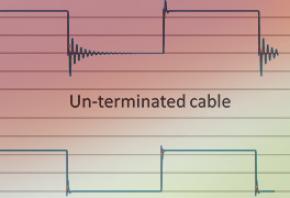Using a Terminating Resistor
Do you need a terminating resistor on your DC IRIG-B (IRIG-B00X) network?
When installing an IRIG-B run, always install a terminating resistor at the end of the cable run. Adding a terminating resistor to the end of the line helps to dampen overshoot for high drive lines and reduce signal noise. The effects of an unterminated line can be seen in figure 1.
Figure 1 – Un Terminated line vs a Terminated Line

Selecting a termination resistor for a DCLS cable run is quite simple, you just need to match the resistor to the impedance of the cable.
For a shielded twisted pair cabling, the cable impedance is usually 120 Ω (e.g. Belden 9841). For coaxial cable, the terminating resistor will depend on what type of cable you use. For RG58 you would expect to use a 50 Ω terminating resistor, and for RG59 a 75 Ω resistor.
When selecting a resistor you will also need to consider the power rating. As DCLS is generally a 5 Vdc signal, you can calculate the power rating easily using
Resistors above a 0.5 W rating in the E24 (5%) range will cover most requirements.
Remember to take the terminating resistor into account when calculating the bus loading, to ensure you do not overload an IRIG-B output.
This blog is an extract from our whitepaper "(Almost) Everything You Need to Know About IRIG-B" which you can download here


